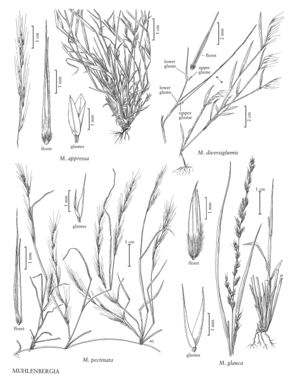Muhlenbergia appressa
Plants annual. Culms 10-42 cm, erect or decumbent, much branched below; internodes mostly scabrous, scabrous or hispidulous below the nodes. Sheaths usually shorter than the internodes, flattened below, glabrous, scabridulous or smooth, striate; ligules 1.5-3 mm, hyaline, acute, lacerate, with lateral lobes; blades 1-5 (7) cm long, 0.8-1.6 (2) mm wide, flat or involute, scabrous abaxially, pubescent adaxially. Panicles 4-23 cm long, 0.5-2 cm wide, usually partially included in the subtending sheaths at maturity; primary branches 20-45 mm, ascending, closely appressed; pedicels 1-5 mm, appressed, scabrous; disarticulation above the glumes. Spikelets 4-7.5 mm, borne singly. Glumes 1-2 mm, 1-veined, veins conspicuous, scabrous, and greenish basally, apices obtuse to subacute, often erose; lemmas 4-6.2 (7.5) mm, narrowly lanceolate, terete, mostly smooth, scabrous distally, hairy on the calluses and lower 1/4 of the margins, hairs 0.2-0.3 mm, whitish, lemma bodies not appearing 5-veined, apices acuminate, awned, awns 10-30 mm, straight, scabrous; paleas 3.8-5.7 (7) mm, narrowly lanceolate; anthers 0.3-1.1 mm, purplish. Caryopses 1.6-3 mm, narrowly fusiform, brownish to pinkish. Cleistogamous spikelets usually present in the axils of the lower leaves. 2n = unknown.
Discussion
Muhlenbergia appressa grows in sandy drainages, canyon bottoms, rocky road cuts, and sandy slopes, at elevations of 20-1750 m. Its range extends from Arizona to Baja California, Mexico. It grows in gramma grasslands, oak-juniper woodlands, and chaparral associations.
Selected References
None.
Lower Taxa
"decumbent" is not a number.
